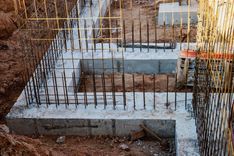Reinforced concrete structures rely on the synergistic relationship between cement and Thermo-Mechanically Treated (TMT) bars. While cement provides compressive strength, TMT bars offer tensile strength, making their combination essential for structural integrity. This article outlines best practices to ensure optimal performance when integrating TMT bars and cement in construction projects.
1. Select appropriate grades of TMT bars and cement
TMT bars - Choose TMT bars that comply with IS 1786 standards. Grades like Fe 500D and Fe 550D are preferred for their balance of strength and ductility, making them suitable for seismic-prone areas.
Cement - Opt for cement types that meet IS 269 standards. Portland Pozzolana Cement (PPC) and Ordinary Portland Cement (OPC) are commonly used. Ensure the cement is fresh and stored properly to maintain its properties.
2. Ensure proper bonding between TMT bars and cement
The bond between TMT bars and cement is crucial for load transfer. TMT bars have ribbed surfaces that enhance mechanical interlocking with concrete. Clean bars free from rust, oil, or paint ensure better adhesion.
3. Maintain correct concrete cover
Adequate concrete cover protects TMT bars from environmental factors and ensures durability. According to IS 456:2000, the minimum cover varies based on exposure conditions, typically ranging from 20mm to 75mm.
4. Adhere to proper placement and spacing of TMT bars
Correct placement and spacing prevent structural weaknesses. Follow design specifications for bar spacing and ensure bars are securely tied at intersections using binding wire.
5. Implement appropriate lap lengths and anchorage
When extending TMT bars, maintain adequate lap lengths to ensure continuity. IS 456:2000 provides guidelines on lap lengths based on bar diameter and grade. Proper anchorage prevents slippage under load.
6. Use quality concrete mix and proper curing
A well-designed concrete mix ensures compatibility with TMT bars. Maintain the correct water-cement ratio and use clean aggregates. After pouring, cure the concrete adequately to achieve desired strength and prevent cracks.
7. Avoid over-reinforcement
Excessive reinforcement can lead to congestion, making it difficult to place and compact concrete properly. Over-reinforcement may also cause cracking and reduce structural efficiency.
8. Conduct regular inspections and maintenance
Periodic inspections help identify issues like corrosion or cracks early. Implement maintenance practices such as sealing cracks and applying protective coatings to extend the structure's lifespan.
Conclusion
Integrating TMT bars and cement effectively is vital for constructing durable and safe reinforced concrete structures. By adhering to these best practices, engineers and builders can ensure structural integrity, longevity, and resilience against environmental challenges.(umcil.co.zm)




 +91 7208055523
+91 7208055523
 Help & support
Help & support
